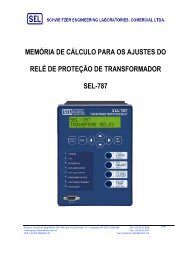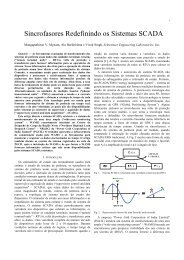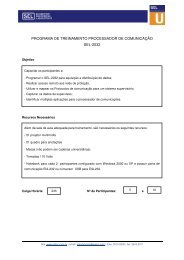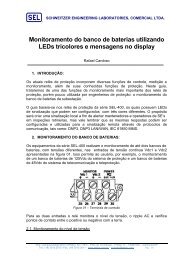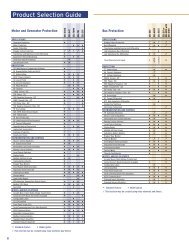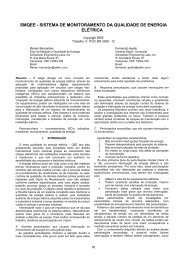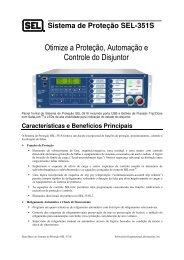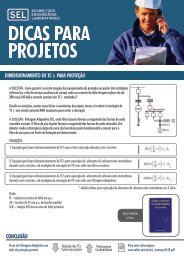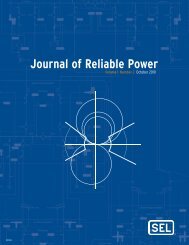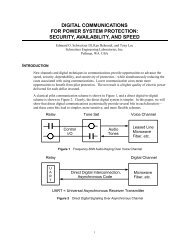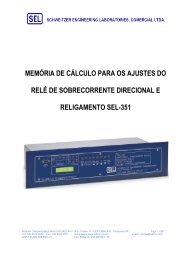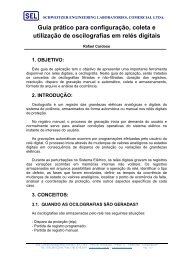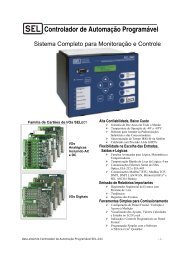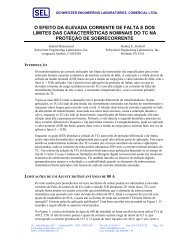Journal of Reliable Power - SEL
Journal of Reliable Power - SEL
Journal of Reliable Power - SEL
Create successful ePaper yourself
Turn your PDF publications into a flip-book with our unique Google optimized e-Paper software.
Digital Communications for <strong>Power</strong> System<br />
Protection: Security, Availability, and Speed<br />
Edmund O. Schweitzer III, Ken Behrendt, and Tony Lee, Schweitzer Engineering Laboratories, Inc.<br />
I. INTRODUCTION<br />
New channels and digital techniques in communications<br />
provide opportunities to advance the speed, security,<br />
dependability, and sensitivity <strong>of</strong> protection—while<br />
simultaneously reducing the costs associated with using<br />
communications. Lower communication costs mean more<br />
opportunities to benefit from pilot protection. The net result is<br />
a higher quality <strong>of</strong> electric power delivered for each dollar<br />
invested.<br />
A classical pilot communication scheme is shown in<br />
Figure 1, and a direct digital-to-digital scheme is shown in<br />
Figure 2. Clearly, the direct digital system is simpler. In this<br />
paper, we will show that direct digital communications<br />
economically provide several bits in each direction—and these<br />
extra bits lead to simpler, more sensitive, and more flexible<br />
schemes.<br />
Figure 1<br />
Figure 2<br />
Frequency-Shift Audio Keying Over Voice Channel<br />
Direct Digital Signaling Over Asynchronous Channel<br />
II. WHAT IS THE CAPACITY OF A CHANNEL<br />
TO COMMUNICATE<br />
How much information can be sent, theoretically and<br />
practically, through a given channel while still maintaining<br />
acceptable reliability<br />
In 1948, Claude E. Shannon [1] mathematically formalized<br />
a theoretical limit. His theory was that information can be<br />
reliably transmitted over a noisy channel if the data<br />
transmission rate is sufficiently low. If the relative noise<br />
increases, the maximum reliable transmission rate decreases.<br />
For instance, a channel with bandwidth W and received noise<br />
power N, can transmit information at rate C with arbitrarily<br />
high dependability, as long as the average signal power P<br />
satisfies:<br />
⎛ P ⎞<br />
C = W log2<br />
⎜ + 1⎟<br />
⎝ N ⎠<br />
The ratio P/N is the signal to noise ratio (SNR). The base<br />
<strong>of</strong> the logarithm depends on how we measure C. When C is<br />
measured in bits per second, the logarithm is base two. In<br />
general, the logarithm base is the number <strong>of</strong> symbols in the<br />
alphabet to be transmitted.<br />
Quieter channels lend themselves to faster data<br />
transmission. Conversely, faster data transmission requires a<br />
quieter channel.<br />
If SNR = P/N = 1, then the Shannon limit is C = W<br />
(bits/second), i.e., the channel capacity for reliable<br />
transmission is the channel bandwidth.<br />
If the SNR = 20dB = 100, then C = 6.7 W (bits/second).<br />
We can see that increasing the SNR gives us an opportunity to<br />
reliably transmit more data, faster.<br />
For example, contrast the channel requirements for two<br />
different transmission rates. A frequency shift keyed (FSK)<br />
audio tone transmission over a voice channel might carry a<br />
single bit <strong>of</strong> information, such as a permissive trip signal.<br />
Suppose we require transmission to occur reliably in 20 ms, so<br />
the required data transmission rate is 1 bit / 20 ms =<br />
50 bits/second. Also assume the receiver filter has a<br />
bandwidth <strong>of</strong> 300 Hz. According to Shannon, the received<br />
signal, after filtering, must have an SNR <strong>of</strong> greater than about<br />
0.1. Before filtering, the SNR on a 3 kHz channel must be<br />
greater than about 0.01, assuming white noise.<br />
A 9600 bits/second data stream transmitted over a 3 kHz<br />
channel requires an SNR <strong>of</strong> at least about 10, according to<br />
Shannon's work. Therefore, the voice grade channel must be<br />
about 10/0.01 or 1000 times quieter (assuming the same<br />
transmit power and modulation techniques) to reliably transfer<br />
data at 9600 baud.<br />
In practice, it is difficult to approach Shannon's limits. The<br />
two examples cited above, when implemented using present<br />
technology, both need about ten times better SNR than<br />
Shannon’s limit.<br />
Both Shannon’s prediction and practical experience show<br />
that when we have a better channel, we can send more<br />
information per unit bandwidth. The quality <strong>of</strong> many digital<br />
channels is excellent, and opens the door to new digital<br />
techniques in protection.<br />
The communications engineer uses encoding and<br />
modulation techniques to approach Shannon’s limit, and to<br />
balance data rate with reliability within the context <strong>of</strong> a given<br />
application.<br />
Digital Communications for <strong>Power</strong> System Protection: Security, Availability, and Speed | 29



